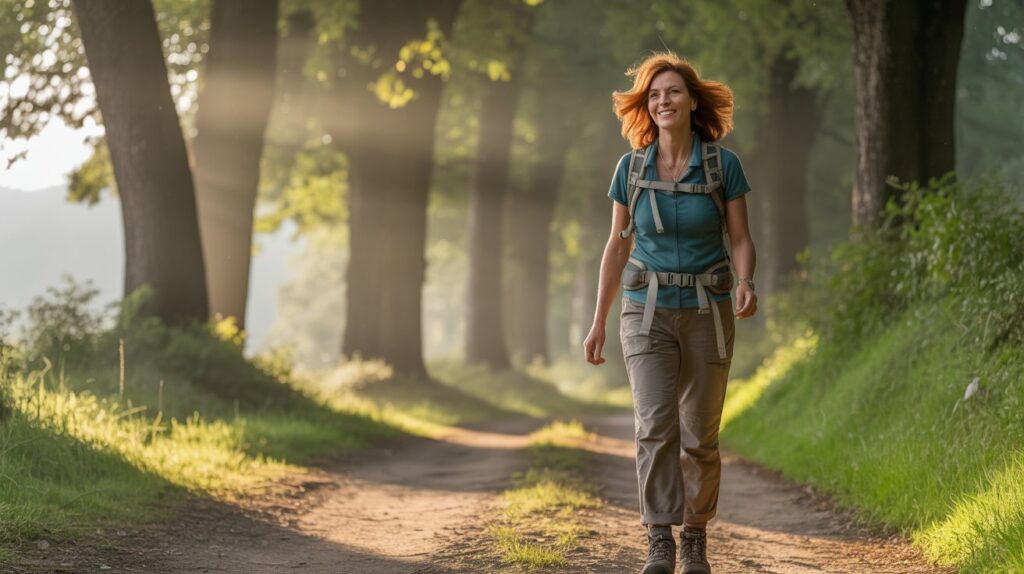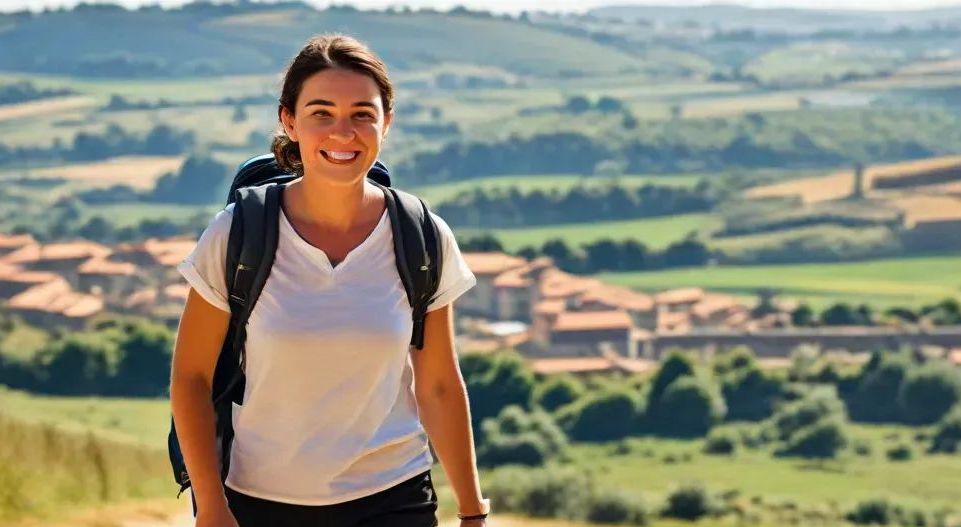Summary
Anxiety loves a stationary target. While our minds spiral into catastrophic thinking, our bodies remain frozen – and therein lies the trap. Action, however small, disrupts anxiety’s stranglehold by engaging our physiology, shifting our focus, and proving that we’re not as powerless as our worried minds would have us believe. It’s not about grand gestures; it’s about strategic movement that transforms paralysis into progress.
Stress destroys Lives. To find out what you can do to safeguard your sanity by taking my insight-giving quiz, subscribe to my mailing list.
Introduction
The email notification pings. Your chest tightens. Another “urgent” request lands in your already overflowing inbox while your phone buzzes with a text from your partner about “needing to talk tonight.” Sound familiar?
Welcome to the modern professional’s daily reality – a relentless cycle of demands that can leave even the most capable among us feeling like we’re drowning in quicksand. The harder we struggle mentally, the deeper we sink into anxiety’s grip.
As someone who has spent two decades as a medical doctor specialising in stress management, followed by ten years guiding exhausted professionals through stress-disolving Camino de Santiago retreats, I’ve witnessed a profound truth: anxiety thrives in immobility, but action breaks its spell.
This isn’t just feel-good philosophy – it’s neuroscience in practice. When we move our bodies, engage our senses, and take concrete steps forward, we literally rewire our brain’s response to stress. The sympathetic nervous system that floods us with cortisol during anxiety attacks is the same system that can be harnessed for purposeful action.
But here’s what most stress management advice gets wrong: the action doesn’t have to be massive. It doesn’t require a complete life overhaul or a dramatic career change. Sometimes, the most powerful antidote to overwhelming anxiety is surprisingly small – a single step, a conscious breath, a deliberate choice to move forward rather than remain frozen.
Dani’s Story: When Everything Falls Apart
The rain hammered against Dani Rogers’ office window as she stared at the resignation letter she’d been drafting and redrafting for three weeks. The cursor blinked mockingly on her screen, as frozen as she felt inside.
At thirty-eight, Dani had built what looked like an enviable life. Senior marketing director at a tech startup, corner office with a view of the city, salary that afforded her a beautiful apartment and regular holidays. But appearances, as she was learning, could be devastatingly deceptive.
The anxiety had crept in slowly, like water through hairline cracks in a dam. First, it was just the Sunday night dread, that familiar knot in her stomach as another punishing week loomed ahead. Then came the 3 AM wake-ups, her mind immediately racing through tomorrow’s impossible to-do list. The final straw had been last Tuesday’s panic attack during a client presentation – the room spinning, her voice catching, forty pairs of eyes watching as she excused herself and fled to the bathroom.
Now her marriage was fracturing too. James had grown tired of her constant worry, her inability to be present during their rare evenings together. “You’re like a ghost,” he’d said the night before, his voice heavy with exhaustion rather than anger. “Even when you’re here, you’re not really here.”
Dani’s hands trembled as she reached for her coffee – her sixth cup that day, though it was barely noon. The bitter taste seemed to coat her tongue like ash. Outside, she could hear the city’s relentless hum: car engines revving, construction hammers pounding, people shouting over the noise. The sounds that once energised her now felt like an assault on her already frayed nerves.
She closed her eyes and could almost smell her grandmother’s kitchen – warm cinnamon and vanilla, the comforting weight of flour-dusted hands guiding hers as they kneaded bread together. “When you don’t know what to do, my darling,” Grandma Rose had always said, “just do the next right thing. Then the next. The path reveals itself one step at a time.”
But what was the next right thing when everything felt wrong?
Dani’s phone buzzed. Another urgent email. Her chest tightened, and she felt that familiar flutter of panic beginning in her stomach. For three weeks, she’d been paralysed by the magnitude of her situation – career crisis, marriage in turmoil, financial obligations, her parents’ expectations. The weight of it all had rendered her motionless, caught between staying in a job that was slowly killing her spirit and making a leap that felt impossibly risky.
Then something shifted. Maybe it was the memory of her grandmother’s voice, or perhaps it was simply that she’d reached the absolute limit of her tolerance for feeling powerless. Dani stood up. Not to pace anxiously as she’d done countless times before, but with intention.
She walked to her desk drawer and pulled out the business card she’d been carrying for months – a career counsellor her friend Maria had recommended. The card was worn at the edges from handling, but she’d never made the call. Her fingers dialled before her mind could intervene with its familiar chorus of “what if” and “but maybe.”
“I’d like to schedule an appointment,” she heard herself saying, her voice steadier than she’d expected.
Thirty minutes. That’s all it took to book the session for the following week. But as Dani hung up the phone, she noticed something remarkable: the knot in her chest had loosened slightly. The anxiety was still there, but it no longer felt all-consuming.
She looked at the resignation letter on her screen, then closed it without saving. Not because she’d changed her mind about leaving, but because she realised she didn’t need to carry the weight of that decision alone anymore.
For the first time in weeks, Dani took a full, deep breath. The rain was still falling, but somehow it sounded less like chaos and more like possibility.
The Science Behind Action as Anxiety’s Antidote
After two decades of medical practice and countless hours supporting stressed professionals, I’ve observed that anxiety creates a particularly cruel trap. It floods our system with stress hormones designed to prepare us for action, yet simultaneously paralyses us with overwhelming thoughts about all the things that could go wrong.
This physiological contradiction is where action becomes revolutionary. When we move our bodies – whether through physical exercise, creative expression, or even simple task completion – we complete the stress cycle our nervous system has initiated. We use the very energy that anxiety has generated, transforming it from a destructive force into a constructive one.
The research supports what I’ve witnessed firsthand during my Camino de Santiago retreats. Neuroplasticity studies show that purposeful action literally rewires our brains, creating new neural pathways that favour resilience over rumination. When we repeatedly choose movement over paralysis, we strengthen the circuits that support effective problem-solving rather than catastrophic thinking.
But here’s the key insight: the action doesn’t need to solve the entire problem to be effective. Often, the most powerful interventions are surprisingly modest. Making that phone call. Sending that email. Taking that walk. These seemingly small actions signal to our nervous system that we are not helpless victims of our circumstances, but active agents in our own lives.
This is why I’ve written extensively about micro-actions in my book “Embracing Change in 10 Minutes a Day.” Change doesn’t require grand gestures; it requires consistent, mindful movement in the direction of our values, even when – especially when – anxiety is screaming at us to stay frozen.
Five Writing Prompts for Exploring Action as Anxiety’s Antidote
- The Paralysis Inventory: Write about a time when anxiety kept you frozen. What specific thoughts were cycling through your mind? What physical sensations did you notice? Now imagine your wisest, most compassionate friend giving advice to someone in your exact situation. What action would they suggest?
- The Smallest Step: Think of a current situation causing you anxiety. Write down the smallest possible action you could take today – something so minor it feels almost silly. What would happen if you took that step? What story are you telling yourself about why even that small action feels impossible?
- The Body Knows: Describe how anxiety feels in your body using only sensory details – no emotions, just physical sensations. Now describe how you feel after taking purposeful action on something that matters to you. What wisdom is your body offering about the relationship between movement and mental state?
- The Future Self Letter: Write a letter from your future self – the version of you who has learned to use action as an antidote to anxiety. What does that person want you to know? What specific actions did they take that shifted everything?
- The Action Audit: For one day, notice every time anxiety arises and track what you do next. Do you scroll social media? Make lists? Call someone? Procrastinate? Without judgment, simply observe the patterns. Then identify one alternative action you could experiment with next time anxiety strikes.
An Enlightening Perspective
“You are never too old to set another goal or to dream a new dream.” – C.S. Lewis
While this quote is often relegated to motivational posters, its wisdom runs deeper than surface inspiration. Lewis understood something profound about human resilience: our capacity for renewal doesn’t diminish with age, experience, or accumulated disappointments. This is particularly relevant when anxiety convinces us that it’s “too late” to change course or take meaningful action.
In my stress management practice, I’ve guided everyone from twenty-five-year-old burnout cases to sixty-plus-year-old executives through major life transitions. The anxiety tells them all the same lie: that their circumstances are too entrenched, their options too limited, their time too short. But action – even a single step toward a new goal or dream – proves anxiety wrong every time.
Dani knew that dreams aren’t luxuries for the young and naive; they’re necessities for anyone who wants to remain alive to life’s possibilities. And action is how we honour those dreams, transforming them from wishful thinking into lived reality.
Further Reading: Unconventional Books for Anxious Professionals
1. “The Artist’s Way” by Julia Cameron
Don’t let the title fool you – Cameron’s morning pages practice and artist dates aren’t just for creatives. These tools help anxious minds find clarity through action, offering a structured way to move from mental chaos to purposeful direction.
2. “Embracing Change in 10 Minutes a Day” by Dr. Margaretha Montagu
My own contribution to the stress management conversation focuses on micro-actions that create macro-changes. Drawing from years of medical practice and Camino retreat experience, this book offers practical strategies for professionals who feel overwhelmed by the prospect of major life changes.
3. “The Body Keeps the Score” by Bessel van der Kolk
This groundbreaking work explains why traditional talk therapy often falls short with anxiety, and why body-based interventions – including physical movement, breathwork, and sensory experiences – are crucial for nervous system regulation.
4. “Digital Minimalism” by Cal Newport
For anxiety triggered by information overload, Newport’s approach to intentional technology use provides concrete actions that reduce mental clutter. His insights about deep work versus shallow work are particularly relevant for overwhelmed professionals.
Guest Testimonial
“I arrived at Dr. Montagu’s Camino retreat in a state of complete mental exhaustion. My anxiety had reached the point where even small decisions felt impossible – what to have for breakfast, which route to take to work, whether to answer a text message. Everything felt monumentally important and simultaneously pointless.
I’ll never forget the morning she had us work with the horses. My Friesian, Tess, simply stood there as I approached, completely present and undemanding. Dr. Montagu asked me to notice what I was feeling in my body, then take one small action – just brush Tess’s neck. That simple motion, repeated slowly and mindfully, was the first time in months I felt truly calm.
The walking days that followed taught me that action doesn’t have to be perfect or even particularly smart – it just has to be intentional. Each step along those ancient paths proved that I could move forward even when I didn’t know where I was going. That retreat didn’t solve all my problems, but it gave me back my agency. Six months later, I’ve changed careers, set boundaries with toxic relationships, and most importantly, learned to trust that taking action – any action – is almost always better than staying frozen in fear.”
– Sarah M., Investment Banker turned Nonprofit Director
Frequently Asked Questions
Q: What if taking action makes my anxiety worse in the short term? A: This is completely normal and often a sign that you’re challenging patterns your nervous system has grown comfortable with. The key is choosing actions that align with your values rather than just reacting to anxiety’s demands. Temporary discomfort during positive change is different from the chronic suffering of remaining stuck.
Q: How do I know which actions to take when everything feels equally urgent? A: Start with your body. Which situation creates the most physical tension when you think about it? Often, our body’s wisdom points us toward what needs attention first. Also, consider which action, if taken, would give you the most peace of mind rather than the most external approval.
Q: I’ve tried taking action before, but nothing changed. Why should this time be different? A: The goal isn’t immediate transformation – it’s interrupting anxiety’s narrative that you’re powerless. Sometimes the most important action is the one that proves to yourself that you can act, regardless of the outcome. Consistency matters more than dramatic results.
Q: What if I take action and make the wrong choice? A: Anxiety loves to present choices as irreversible catastrophes. In reality, most decisions can be adjusted, refined, or completely changed as new information emerges. The “wrong” choice that teaches you something valuable is infinitely more useful than the “right” choice you’re too afraid to make.
Q: How can action help when my anxiety is about things beyond my control? A: Focus on your sphere of influence rather than your sphere of concern. You can’t control external circumstances, but you can control your response to them. Sometimes the most powerful action is accepting what you cannot change while committing to what you can.
Key Takeaways
- Anxiety thrives in stillness – Mental rumination without physical action creates a breeding ground for catastrophic thinking. Movement, even minimal, interrupts this cycle.
- Small actions create big shifts – You don’t need to overhaul your entire life to feel better. Sometimes a single phone call, email, or conversation can shift your entire perspective.
- Your body is your ally – Physical sensations often provide clearer guidance than mental analysis. Learn to trust what your nervous system is telling you about different choices.
- Progress beats perfection – The goal isn’t to eliminate anxiety entirely but to prevent it from paralysing you. Action builds evidence that you can move forward despite uncomfortable feelings.
- Action builds self-trust – Each time you choose purposeful movement over anxious paralysis, you strengthen your belief in your own capability. This self-trust becomes your most reliable resource during future challenges.
Conclusion
The relationship between action and anxiety isn’t about forcing yourself to be productive when you’re struggling – it’s about recognizing that you have more power than your worried mind would have you believe. After twenty years in medicine and ten years guiding professionals through transformative experiences, I’ve learned that the antidote to feeling powerless is proving to yourself, through concrete actions, that you are anything but.
Your anxiety isn’t a character flaw or a sign of weakness; it’s often a signal that you’re caring deeply about your life and its direction. The question isn’t how to eliminate these feelings entirely, but how to move forward with them as companions rather than masters.
Remember Dan’s story – her transformation didn’t begin with having all the answers or feeling completely confident. It began with one phone call, one small step toward reclaiming her agency. Your path forward might look different, but the principle remains the same: action, however modest, is always available to you.
Discover Your Path to Peace: Camino de Santiago Stress Relief Retreats
Imagine walking ancient paths through the rolling countryside of southwest France, your mind finally quiet, your body strong, and your spirit renewed. This isn’t just a holiday – it’s a transformative journey back to yourself.
My seven-day Camino de Santiago retreats near Eauze offer something you won’t find in any boardroom or therapy office: the profound healing that happens when you combine gentle movement, mindful presence, and the extraordinary wisdom of horses. Each morning begins with meditation among my Friesian and Falabella horses, creatures whose natural presence teaches us what it means to be truly centred in the moment.
These aren’t your typical wellness retreats filled with rigid schedules and performance pressure. Instead, you’ll discover the revolutionary power of slowing down, of taking one mindful step at a time along paths that have been walked by seekers for over a thousand years. Through guided walking meditation, equine-assisted mindfulness sessions, and evening reflections under the French stars, you’ll learn practical tools for managing stress that you can carry back into your demanding professional life.
The magic happens not just in the walking, but in the spaces between steps – those moments of silence where clarity emerges and anxiety loosens its grip. Previous guests consistently report not just feeling more relaxed, but fundamentally changed in their relationship with stress and uncertainty.
Small groups, personalised attention, and the gentle guidance of both human and equine teachers create an environment where true transformation becomes possible. Because sometimes, the most powerful action you can take is to step away from the chaos and remember who you are beneath all the pressure and expectations.
Join me for a transformative stress-relief retreat along the Camino de Santiago in southwestern France. Our week-long programs combine mindful hiking, meditation practices, and unique sessions with my gentle Friesian and Falabella horses – proven to lower cortisol and restore nervous system balance. Small groups, personal attention, and the ancient wisdom of the pilgrimage path await. Because sometimes the best way forward is to walk together.
Learn more about my upcoming retreats and see testimonials from past guests.










10 Powerful Life Lessons Learned While Walking the Camino de Santiago – a free guide filled with 10 not just “quaint anecdotes” or Instagram-worthy moments (though there are plenty of those) but real transformations from real people who walked the same insight-giving trail you might want to walk one day – Subscribe to my monthly newsletter to Download the Guide

Author Bio: Dr Margaretha Montagu – described as a “game changer”, “gifted healer”, “guiding light” and “life-enriching author” – is an experienced medical doctor, a certified NLP practitioner, a medical hypnotherapist, an equine-assisted psychotherapist (EAGALAcertified) and a transformational retreat leader who guides her clients through life transitions – virtually, or with the assistance of her Friesian and Falabella horses, at their home in the southwest of France.

